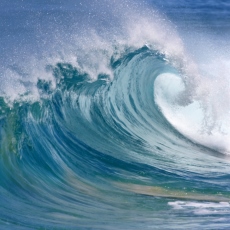
A tsunami is a series of huge ocean waves created by an underwater disturbance. Causes include earthquakes, landslides, volcanic eruptions, or meteorites--chunks of rock from space that strike the surface of Earth. A tsunami can move hundreds of miles per hour in the open ocean. It can smash into land with waves as high as 100 feet or more and cause devastating floods. Drowning is the most common cause of death related to a tsunami.
Although there are no guarantees of safety during a tsunami, you can take actions to protect yourself. You should have a disaster plan. Being prepared can help reduce fear, anxiety, and losses. If you do experience a disaster, it is normal to feel stressed. You may need help in finding ways to cope.
- Tsunamis (National Library of Medicine)A tsunami is a series of huge ocean waves created by an underwater disturbance. Causes include earthquakes, landslides, volcanic ... space that strike the surface of Earth. A tsunami can move hundreds of miles per hour in ...
- Tsunami Preparedness (American Red Cross)Tsunamis/Learn More ... Tsunamis ... American Red Cross ... Get American Red Cross preparedness tips that can help you survive a tsunami. We will help you understand ...
- Tsunamis (Centers for Disease Control and Prevention)Tsunamis, also known as seismic sea waves, are a series of enormous waves created by an underwater ... an earthquake, landslide, volcanic eruption, or meteorite. A tsunami can strike anywhere along most of the U.S. ...
- Tsunamis (Department of Homeland Security)... what to do if you are under a tsunami warning and how to stay safe when a tsunami threatens. Prepare Now Survive During Be Safe After ...
- Tsunamis: Water Quality (Centers for Disease Control and Prevention)Information about Water Quality After a Tsunami provided by the Centers for Disease Control and Prevention (CDC) ... Water Quality After a Tsunami, chemical contaminants often found in floodwater, ... diarrhea, cholera, infections, Safe water for drinking, flooding, ...
- Health Effects of Tsunamis (Centers for Disease Control and Prevention)Immediate, Secondary, and Long-lasting Effects of Tsunamis. Information provided by the Centers for Disease Control and Prevention (CDC) ... immediate health concerns of tsunamis, public health, flood waters, shelter, ... effects of tsunamis, water systems, insect transmitted diseases, Centers ...
- What You Need to Know When the Power Goes Out Unexpectedly (Centers for Disease Control and Prevention)What You Need to Know When the Power Goes Out Unexpectedly. Tips and Information on Power Outage Safety provided by the Centers for Disease Control and ...
- Prevent Hypothermia and Frostbite (Centers for Disease Control and Prevention)Hypothermia (abnormally low body temperature) and frostbite are both dangerous conditions that can happen when a person is exposed to extremely cold temperatures. ...
- Stay Safe after a Wildfire (Centers for Disease Control and Prevention)Wildfires/Learn More ... Wildfires ... Centers for Disease Control and Prevention ... The Centers for Disease Control and Prevention (CDC) provides information on how ...
- Clean Up Safely after a Disaster (Centers for Disease Control and Prevention)Disaster Preparation and Recovery/Related Issues ... Disaster Preparation and Recovery ... Centers for Disease Control and Prevention ... Take steps to protect yourself ...



